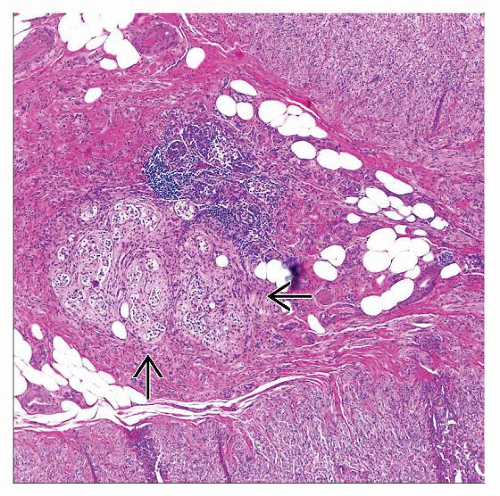
For 20 years, this CD patient had intermittent severe right lower quadrant abdominal pain not due to CD, but rather due to an appendiceal neuroma (fibrous obliteration of the appendix).

Although CD may be present in 1 part of the intestine, severe symptoms elsewhere can occur that are not due to CD. Our patient demonstrates that clinically significant appendiceal neuromas may present with debilitating chronic intermittent right lower quadrant abdominal pain, which may be confused with CD. 9 Both carcinoid tumors and mucinous cystadenomas are also well described as occurring in the appendices of patients with IBD. 9 Nonspecific changes including fibrous obliteration (appendiceal neuroma), serosal fibrosis, lymphoid hyperplasia, and neuronal hyperplasia were observed in 8 of 41 (20%) of the appendices. 9 In one study of 41 children with CD or UC who underwent appendectomy, 33 out of 41 (80%) appendices were abnormal with pathologic changes consistent with IBD. Most appendices removed from IBD patients are involved with chronic inflammation due to CD or ulcerative colitis (UC). 3 In some cases, fibrous obliteration of the appendix (appendiceal neuroma) is the only finding that would explain the symptoms of what clinically was thought to be chronic appendicitis. 7, 8 However, in chronic appendicitis the incidence of appendiceal neuromas has been reported to be as high as 51.2%. 1, 2 Most appendiceal neuromas are found incidentally in asymptomatic patients after pathological examination of the appendix reveals fibrous obliteration. 4, – 6 The association of appendiceal neuromas (fibrous obliteration of the appendix) with clinical symptoms, such as abdominal pain, has been unclear. 2 Serotonin and substance P have been found in the nerve fibers within appendiceal neuromas (fibrous obliteration of the appendix), and it has been hypothesized that these neuropeptides may promote muscular spasticity and abnormal peristalsis leading to abdominal pain in some patients. 1, – 6 Appendiceal neuromas are rare, and in 1 study of 8699 patients who underwent appendectomy, only 5 appendiceal neuromas were observed out of a total of 101 appendiceal tumors. Following the appendectomy the patient has felt markedly improved for the past 4 years, with complete resolution of her intermittent severe right lower quadrant abdominal pain.Īppendiceal neuromas (fibrous obliteration of the appendix) contain spindle cells with eosinophilic processes within a fibrous or fibroadipose stroma. Pathology of the appendix revealed no evidence of active appendicitis or CD, but did demonstrate luminal fibrous obliteration, consistent with an appendiceal neuroma. Despite a normal-appearing appendix, an appendectomy was performed due to the 20-year history of unexplained intermittent severe right lower quadrant abdominal pain. An exploratory laparotomy was undertaken, but revealed no evidence of CD involving the terminal ileum or right colon. The patient was treated with steroids and antibiotics, but continued to have very severe right lower quadrant abdominal pain. Colonoscopy revealed mild to moderate left-sided colitis, but no evidence of CD of the right colon or terminal ileum. Abdominal computed tomography (CT) scan demonstrated evidence of left-sided colitis and possible inflammatory changes in the right lower quadrant. Erythrocyte sedimentation rate (ESR) and C-reactive protein (CRP) were normal. Complete blood count (CBC) demonstrated mild anemia and thrombocytosis.

The patient had localized right lower quadrant abdominal tenderness without guarding or rebound. It had been presumed, but unable to be proven, that her right lower quadrant abdominal pain was due to CD of the ileum. However, her intermittent severe right lower quadrant abdominal pain persisted and intensified.

She had had multiple CD flares, which had been treated with steroids and antibiotics. 3, – 7 We present a patient with left-sided colonic Crohn's disease (CD) who also had 20 years of intermittent severe right lower quadrant pain the pain was thought to be due to CD involving the terminal ileum, but was due to an appendiceal neuroma (fibrous obliteration of the appendix).Ī 39-year-old woman presented with moderate to severe CD of the left colon and also with intermittent severe right lower quadrant abdominal pain for 20 years. 1, 2 Appendiceal neuromas are proliferations of neural tissue and are categorized as one of the causes of fibrous obliteration of the appendix. Primary tumors of the appendix are uncommon and are usually not included in the differential diagnosis when a patient with inflammatory bowel disease (IBD) presents with either acute or chronic right lower quadrant abdominal pain.


 0 kommentar(er)
0 kommentar(er)
